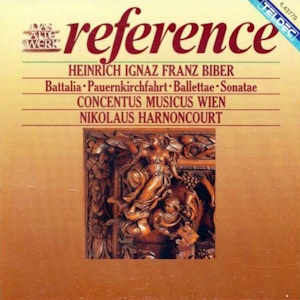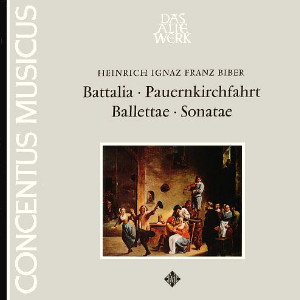 |
| 1 CD -
8.43779 ZS - (c) 1987 |
 |
1 LP -
SAWT 9579-B - (p) 1971
|
|
BATTALIA · PAUERNKIRCHFAHRT ·
BALLETTAE · SONATAE
|
|
|
|
|
|
|
|
|
|
| Heinrich Ignaz
Franz BIBER (1644-1704) |
Sonata
III a 5 Violae |
|
4' 545" |
1 |
A1
|
|
- (Allegro)
- Adagio - Presto - Allegro - Presto -
Adagio |
|
|
|
|
|
Sonata
prima a 8, 2 Clarini, 6 Violae |
* |
5' 09" |
2 |
A2
|
|
- (Allegro)
- Adagio - Presto - Adagio - Allegro |
|
|
|
|
|
Ballettae
a 4 Violettae |
|
6' 58" |
3 |
A3
|
|
- 1; 2;
3; 4; 5. (Gavotte); 6. (Loure); 7.
(Minuett) |
|
|
|
|
|
Battalia |
|
7' 27" |
4 |
A4
|
|
Das
liederliche Schwärmen der Musquetirer,
Mars, die Schlacht, undt Lamento der
Verwundten, mit Arien imitirt undt
Baccho dedicirt, von H. Biber, Ao. 1673 |
|
|
|
|
|
Sonata
à 7, 6 Tromb. Tramburin con Organo, Ao.
1668 |
|
6' 13" |
5 |
B1
|
|
Sonata IV a 5 Violae |
|
4' 10" |
6 |
B2
|
|
- Allegro
- Adagio - Prestissimo |
|
|
|
|
|
Sonata
seconda a 8, e Clarini, 6 Violae |
|
5' 25" |
7 |
B3
|
|
- (Allegro)
- Adagio - Allegro - Adagio - Presto |
*
|
|
|
|
|
Sonata
à 6, die
Pauern Kirchfahrt genandt |
|
7' 55" |
8 |
B4 |
|
- Adagio
- Presto - die Pauern Kirchfahrt -
Adagio - Aria - Aria |
|
|
|
|
|
|
|
|
|
CONCENTUS
MUSICUS WIEN (with original
instruments)
- Josef Spindler, Clarintrompete*
- Walter Holy, Clarintrompete
- Ingus Schmidt, Clarintrompete
- Richard Rudolf, Clarintrompete
- Hermann Schober, Clarintrompete*
- Günter Spindler, Clarintrompete
- Kurt Hammer, Barockpauken
- Alice Harnoncourt, Barockvioline
- Walter Pfeiffer, Barockvioline
- Peter Schoberwalter, Barockvioline
- Josef de Sordi, Viola
- Kurt Theiner, Tenorbratsche
- Nikolaus Harnoncourt, Tenorviola
- Hermann Höbarth, Violoncello
- Eduard Hruza, Violone
- Herbert Tachezi, Cembalo, Orgel
Nikolaus HARNONCOURT, Conductor
|
|
|
|
|
Luogo
e data di registrazione |
|
Casino
Zögernitz, Vienna (Austria) -
March 1971 |
|
|
Registrazione:
live / studio |
|
studio |
|
|
Producer |
|
-
|
|
|
Prima Edizione
LP |
|
Telefunken
- SAWT 9579-B - (1 LP) - durata
50' 33" - (p) 1971 - Analogico
|
|
|
Edizione
"Reference" CD
|
|
Tedec
- 8.43779 ZS - (1 CD) - LC 3706 -
durata 50' 33" - (c) 1987 - AAD |
|
|
Cover |
|
Detail
aus einem barocken Bilderrahmen
mit König David, Musen, Tugenden
und Lastem. Buchsbaumholz /
Holland gegen 1670, mit
freundlicher Genehmigung des
Museums für Kunst und Gewerbe,
Hamburg
|
|
|
Note |
|
-
|
|
|
|
|
All
the works
played here
were composed
by Heinrich
Ignaz Franz
Biber for the
Archbishop of
Olmütz’s
famous
virtuoso
orchestra. He
later included
some of them
(both
eight-part
sonatas with
two trumpets
and both
five~part
Sonatas for
strings) in
his collection
“Sonate tam
aris quam
aulis...,
1676”, partly
rewriting them
in the
process. (Here
they are
performed in
the autograph
first version
of Kremsier.)
The Sonata in
Seven Parts is
an unusual
piece even
within the
context of the
trumpet music
of the 17th
century. Each
group of
trumpeters was
then divided
into high
(clarino),
middle
(principal)
and low
(coarse and
lazy)
trumpeters.
Here Biber
requires the
highest and
the lowest
notes alike
from each of
the six
trumpeters;
such demands
could probably
only be made
at that time
of the
Kremsier group
of trumpeters,
whose leader
was the famous
Pavel
Vejvanowsky.
In the second
part of the
sonata, in
which Biber
takes the
natural
trumpets
outside their
normally
rcstrictcd
scope of D
major, he lets
three pairs of
duettists play
successiverly
in concertante
style before
the Finale
proper begins
with a divided
flourish (lst,
3rd and 4th
trumpets
against 2nd,
5th and 6th).
In the two
Sonatas in
Eight Parts,
Biber uses
three groups:
two trumpets
in highly
virtuoso solo
writing, two
violins given
the same solo
treatment and
four viols.
The latter are
used in the
tutti as
contrapuntally
accompanying
middle parts,
but also play
alone in the
Adagio
sections as a
darker
contrast to
the high solo
instruments.
These pieces
are unique
anticipatory
mixed forms of
solo concerto,
concerto
grosso and
sonata.
The two String
Sonatas in
Five Parts
are, like all
Biber’s
sonatas,
basically in
one movement.
A wealth of
ideas and
statcrncnts,
harmonic and
motivic in
nature, are
presented in
the greatest
variety of
metres, one
after the
other and also
contrapuntally
one over
another-
always in the
manner of
speech and
counter-speech
with agreement
nearly always
being clearly
reached at the
end. In
between,
hornophonic,
dance-like
sections are
repeatedly
interspersed
by way of
relaxation.
In the
“Pauernkirchfahrt”
(Peasants’
Church
Procession) a
rural
processional
feast-day is
depicted: the
gathering of
the old people
and the
children, the
wandering
procession
with the
litany singing
of the men and
women which,
on entering
the church,
merges almost
imperceptibly
with the sound
of the organ
(bow vibrato),
a fervent hymn
and the self
-understood
conclusion to
every country
feast-day in
thc village
inn. In order
to conclude
the piece in a
more
“decorous”
manner, a
conventional
dance-movement
follows as the
Finale.
The “Battalia”
(Battle) is
similarly
constructed.
Biber depicts
the army camp
with trumpet
and drum
motifs, and
has written
precise
instructions
in each case
(“NB.: where
there are
lines, instead
of being
played with
the boy the
violins must
be tapped, it
must be well
rehearsed").
There follows
the “dissolute
company full
of humour,” in
which eight
drunken
musketeers
evidently sing
the song of
their
homelands
(“hic
dissonant
ubique, nam
enim sic
diversis
cantilenis
clamore
solent” - here
all parts are
dissonant, for
various songs
are shouted
together at
the same
time). Some of
the songs have
been
identified
(]iȓi Sehnal,
Brün n): l.
“Ne takes my
mluvuel” is a
Slovak
folk-song, 2.
“vojansky
figator” was
still known in
Bohemia in the
18th century,
3. “Kraut und
Ruben” was
known as a
’bergamasca’
in Northern
Italy, Austria
and Hungary,
6. Nambli wol
kan ich ietzt
glauben” a
Styrian
tolk-song.
After this
picture, which
shows the
common
soldiers,
there follows
an elegant
fencing scene
ofthe
officers,
after this the
March (“NB.:
the March is
already known
[in Biber’s
violin sonata
Repraesentafio
Aviurn] but I
have not known
how better to
use it, where
the drum goes
in the bass
one must put a
paper on the
string, so
that a noise
is produced,
but only in
the March”).
There then
follows a
horsemen's
piece in 3/4
and an aria
that
represents the
warrior’s
farewell to
his family,
then the
battle with
flourishes of
trumpets and
shots (NB.:
the Battle
must not he
played with
the bow, but
the string
snapped with
the right hand
like the
pieces [of
artillery],
and
stronglyl”).
The works ends
with the
“Lamento ofthe
Wounded
Musketeers.”
Balletae a 4
is a suit-like
sequence of
dance
movements
designated
only by
numbers. Biber
here tries
out, in
primarily
hornophonic
writing,
complex
rhythmical
further
developements
of, and even
departures
from, the
traditional
dance forms:
Allemnnde,
Galliarde,
Minuet,
Gavotte,
Siliana. The
entire is
pervaded by
folk-music
motifs.
Nikolaus
Harnoncourt
|
|